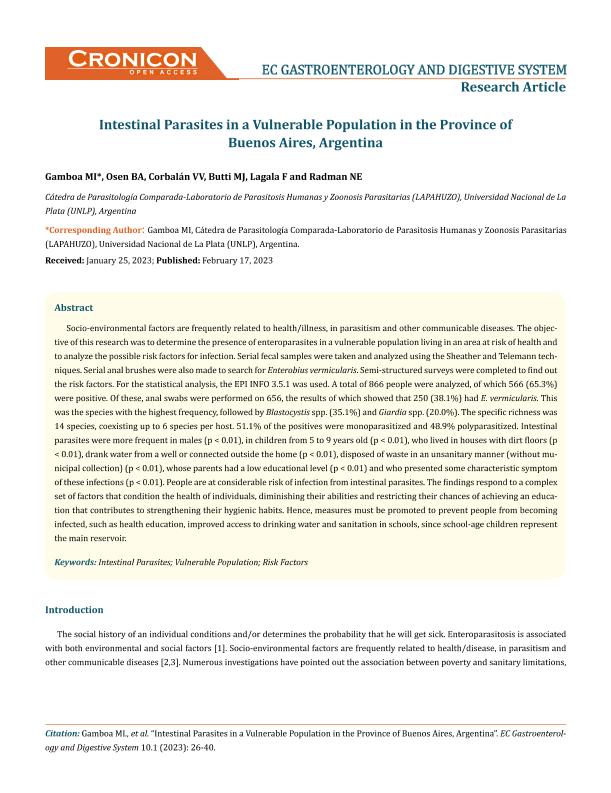Artículo
Intestinal Parasites In A Vulnerable Population In The Province Of Buenos Aires, Argentina
Gamboa, María Inés; Osen, Beatriz Amelia; Corbalán, Valeria Vanesa ; Butti, M.J.; Lagala, Fiamma Hebe; Radman, Nilda Ester
; Butti, M.J.; Lagala, Fiamma Hebe; Radman, Nilda Ester
 ; Butti, M.J.; Lagala, Fiamma Hebe; Radman, Nilda Ester
; Butti, M.J.; Lagala, Fiamma Hebe; Radman, Nilda Ester
Fecha de publicación:
02/2023
Editorial:
Ecronicon
Revista:
EC Gastroenterology and Digestive System
ISSN:
2453-188X
Idioma:
Inglés
Tipo de recurso:
Artículo publicado
Clasificación temática:
Resumen
Socio-environmental factors are frequently related to health/illness, in parasitism and other communicable diseases. The objective of this research was to determine the presence of enteroparasites in a vulnerable population living in an area at risk of health and to analyze the possible risk factors for infection. Serial fecal samples were taken and analyzed using the Sheather and Telemann techniques. Serial anal brushes were also made to search for Enterobius vermicularis. Semi-structured surveys were completed to find out the risk factors. For the statistical analysis, the EPI INFO 3.5.1 was used. A total of 866 people were analyzed, of which 566 (65.3%) were positive. Of these, anal swabs were performed on 656, the results of which showed that 250 (38.1%) had E. vermicularis. This was the species with the highest frequency, followed by Blastocystis spp. (35.1%) and Giardia spp. (20.0%). The specific richness was 14 species, coexisting up to 6 species per host. 51.1% of the positives were monoparasitized and 48.9% polyparasitized. Intestinal parasites were more frequent in males (p < 0.01), in children from 5 to 9 years old (p < 0.01), who lived in houses with dirt floors (p < 0.01), drank water from a well or connected outside the home (p < 0.01), disposed of waste in an unsanitary manner (without municipal collection) (p < 0.01), whose parents had a low educational level (p < 0.01) and who presented some characteristic symptom of these infections (p < 0.01). People are at considerable risk of infection from intestinal parasites. The findings respond to a complex set of factors that condition the health of individuals, diminishing their abilities and restricting their chances of achieving an education that contributes to strengthening their hygienic habits. Hence, measures must be promoted to prevent people from becoming infected, such as health education, improved access to drinking water and sanitation in schools, since school-age children represent the main reservoir.
Palabras clave:
Intestinal Parasites
,
Vulnerable population
,
Risk factors
Archivos asociados
Licencia
Identificadores
Colecciones
Articulos(CEPAVE)
Articulos de CENTRO DE EST.PARASITOL.Y DE VECTORES (I)
Articulos de CENTRO DE EST.PARASITOL.Y DE VECTORES (I)
Citación
Gamboa, María Inés; Osen, Beatriz Amelia; Corbalán, Valeria Vanesa; Butti, M.J.; Lagala, Fiamma Hebe; et al.; Intestinal Parasites In A Vulnerable Population In The Province Of Buenos Aires, Argentina; Ecronicon; EC Gastroenterology and Digestive System; 10; 1; 2-2023; 26-40
Compartir



